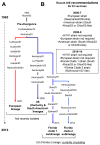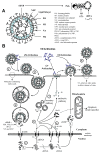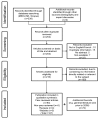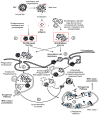A Systematic Review of Recent Advances in Equine Influenza Vaccination
- PMID: 26344892
- PMCID: PMC4494246
- DOI: 10.3390/vaccines2040797
A Systematic Review of Recent Advances in Equine Influenza Vaccination
Abstract
Equine influenza (EI) is a major respiratory disease of horses, which is still causing substantial outbreaks worldwide despite several decades of surveillance and prevention. Alongside quarantine procedures, vaccination is widely used to prevent or limit spread of the disease. The panel of EI vaccines commercially available is probably one of the most varied, including whole inactivated virus vaccines, Immuno-Stimulating Complex adjuvanted vaccines (ISCOM and ISCOM-Matrix), a live attenuated equine influenza virus (EIV) vaccine and a recombinant poxvirus-vectored vaccine. Several other strategies of vaccination are also evaluated. This systematic review reports the advances of EI vaccines during the last few years as well as some of the mechanisms behind the inefficient or sub-optimal response of horses to vaccination.
Keywords: equid; equine influenza; vaccine.
Figures





Similar articles
-
ISCOM-matrix-based equine influenza (EIV) vaccine stimulates cell-mediated immunity in the horse.Vet Immunol Immunopathol. 2012 Jan 15;145(1-2):516-21. doi: 10.1016/j.vetimm.2011.11.019. Epub 2011 Nov 26. Vet Immunol Immunopathol. 2012. PMID: 22178272
-
Whole inactivated equine influenza vaccine: Efficacy against a representative clade 2 equine influenza virus, IFNgamma synthesis and duration of humoral immunity.Vet Microbiol. 2013 Mar 23;162(2-4):396-407. doi: 10.1016/j.vetmic.2012.10.019. Epub 2012 Oct 24. Vet Microbiol. 2013. PMID: 23146168
-
Protection, systemic IFNgamma, and antibody responses induced by an ISCOM-based vaccine against a recent equine influenza virus in its natural host.Vet Res. 2008 May-Jun;39(3):21. doi: 10.1051/vetres:2007062. Epub 2008 Feb 7. Vet Res. 2008. PMID: 18252187 Clinical Trial.
-
How to Meet the Last OIE Expert Surveillance Panel Recommendations on Equine Influenza (EI) Vaccine Composition: A Review of the Process Required for the Recombinant Canarypox-Based EI Vaccine.Pathogens. 2016 Nov 25;5(4):64. doi: 10.3390/pathogens5040064. Pathogens. 2016. PMID: 27897990 Free PMC article. Review.
-
Vaccination against equine influenza: quid novi?Vaccine. 2006 May 8;24(19):4047-61. doi: 10.1016/j.vaccine.2006.02.030. Epub 2006 Feb 28. Vaccine. 2006. PMID: 16545507 Review.
Cited by
-
An Overview of Equine Influenza in South America.Viruses. 2021 May 12;13(5):888. doi: 10.3390/v13050888. Viruses. 2021. PMID: 34065839 Free PMC article. Review.
-
Equine Influenza Virus: An Old Known Enemy in the Americas.Vaccines (Basel). 2022 Oct 14;10(10):1718. doi: 10.3390/vaccines10101718. Vaccines (Basel). 2022. PMID: 36298583 Free PMC article. Review.
-
Characterisation of the epidemic strain of H3N8 equine influenza virus responsible for outbreaks in South America in 2012.Virol J. 2016 Mar 19;13:45. doi: 10.1186/s12985-016-0503-9. Virol J. 2016. PMID: 26993620 Free PMC article.
-
Development of a novel equine influenza virus live-attenuated vaccine.Virology. 2018 Mar;516:76-85. doi: 10.1016/j.virol.2018.01.005. Epub 2018 Jan 11. Virology. 2018. PMID: 29331866 Free PMC article.
-
Systematic Review of Equine Influenza A Virus Vaccine Studies and Meta-Analysis of Vaccine Efficacy.Viruses. 2023 Nov 28;15(12):2337. doi: 10.3390/v15122337. Viruses. 2023. PMID: 38140577 Free PMC article.
References
-
- Landolt G., Townsend H.G., Lunn D.P. Equine influenza infection. In: Sellon D.C., Long M.T., editors. Equine Infectious Diseases. Saunders Elsevier; St Louis, MO, USA: 2007. pp. 124–134.
-
- Wilson W.D. Equine influenza. Vet. Clin. North Am. Equine Pract. 1993;9:257–282. - PubMed
-
- Hannant D., Mumford J.A. Equine influenza. In: Studdert M.J., Horzinek M.C., editors. Virus Infections of Vertebrates. Elsevier Science Publishers; Amsterdam, The Netherlands: 1996. pp. 285–293. Volume Virus Infections of Equines.
-
- Miller W.C. Equine influenza. Further observations on the “Coughing” Outbreak, 1965. Vet. Rec. 1965;77:455–456. - PubMed
-
- Peek S.F., Landolt G., Karasin A.I., Slack J.A., Steinberg H., Semrad S.D., Olsen C.W. Acute respiratory distress syndrome and fatal interstitial pneumonia associated with equine influenza in a neonatal foal. J. Vet. Intern. Med. 2004;18:132–134. doi: 10.1111/j.1939-1676.2004.tb00149.x. - DOI - PubMed
Publication types
LinkOut - more resources
Full Text Sources
Other Literature Sources

